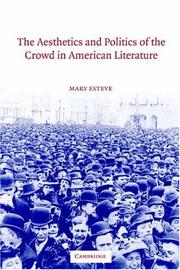| Listing 1 - 5 of 5 |
Sort by
|

ISBN: 1107133866 1280161337 0511120648 1139148206 0511064977 0511058640 0511305818 0511485492 0511073437 9780511064975 9780511073434 9780511120640 9780521814881 052181488X 9780511485497 9781280161339 9786610161331 661016133X 9780521035903 0521035902 9781107133860 9781139148207 9780511058646 9780511305818 Year: 2003 Publisher: Cambridge, UK ; New York : Cambridge University Press,
Abstract | Keywords | Export | Availability | Bookmark
 Loading...
Loading...Choose an application
- Reference Manager
- EndNote
- RefWorks (Direct export to RefWorks)
Mary Esteve provides a study of crowd representations in American literature from the antebellum era to the early twentieth century. As a central icon of political and cultural democracy, the crowd occupies a prominent place in the American literary and cultural landscape. Esteve examines a range of writing by Poe, Hawthorne, Lydia Maria Child, Du Bois, James, and Stephen Crane among others. These writers, she argues, distinguish between the aesthetics of immersion in a crowd and the mode of collectivity demanded of political-liberal subjects. In their representations of everyday crowds, ranging from streams of urban pedestrians to swarms of train travellers, from upper-class parties to lower-class revivalist meetings, such authors seize on the political problems facing a mass liberal democracy - problems such as the stipulations of citizenship, nation formation, mass immigration and the emergence of mass media. Esteve examines both the aesthetic and political meanings of such urban crowd scenes.
American literature --- Crowds in literature. --- Politics and literature --- Literature and society --- Collective behavior in literature. --- City and town life in literature. --- Immigrants in literature. --- Lynching in literature. --- Aesthetics, American. --- Mobs in literature. --- Race in literature. --- American aesthetics --- Literature --- Literature and politics --- History and criticism. --- Political aspects --- Arts and Humanities
Book
ISBN: 9781503613942 1503613941 9781503614376 1503614379 Year: 2021 Publisher: Stanford Stanford University Press
Abstract | Keywords | Export | Availability | Bookmark
 Loading...
Loading...Choose an application
- Reference Manager
- EndNote
- RefWorks (Direct export to RefWorks)
This book offers a revisionist literary and cultural history of the postwar era to document how writers of realist fiction worked to advance the crucial value of public institutions and ongoing pursuits of socioeconomic justice within the symbolic economy of welfare-state liberalism.
American fiction --- Authors, American --- Happiness in literature --- Welfare state in literature --- Liberalism in literature --- Realism in literature --- History and criticism --- Political and social views
Book
ISBN: 1503614387 9781503614383 9781503613942 9781503614376 1503613941 1503614379 Year: 2021 Publisher: Stanford, California
Abstract | Keywords | Export | Availability | Bookmark
 Loading...
Loading...Choose an application
- Reference Manager
- EndNote
- RefWorks (Direct export to RefWorks)
The postwar US political imagination coalesced around a quintessential midcentury American trope: happiness. In Incremental Realism, Mary Esteve offers a bold, revisionist literary and cultural history of efforts undertaken by literary realists, public intellectuals, and policy activists to advance the value of public institutions and the claims of socioeconomic justice. Esteve specifically focuses on era-defining authors of realist fiction—including Philip Roth, Gwendolyn Brooks, Patricia Highsmith, Paula Fox, Peter Taylor, and Mary McCarthy—who mobilized the trope of happiness to reinforce the crucial value of public institutions, such as the public library, and the importance of pursuing socioeconomic justice, as envisioned by the United Nations Universal Declaration of Human Rights and welfare-state liberals. In addition to embracing specific symbols of happiness, these writers also developed narrative modes—what Esteve calls "incremental realism"—that made justifiable the claims of disadvantaged Americans on the nation-state and promoted a small-canvas aesthetics of moderation. With this powerful demonstration of the way postwar literary fiction linked the era's familiar trope of happiness to political arguments about socioeconomic fairness and individual flourishing, Esteve enlarges our sense of the postwar liberal imagination and its attentiveness to better, possible worlds.
American fiction --- Authors, American --- History and criticism. --- Political and social views. --- American cultural history. --- happiness. --- incremental realism. --- liberalism. --- postwar American fiction. --- public institutions. --- socioeconomic justice. --- welfare state. --- Happiness in literature --- Welfare state in literature --- Liberalism in literature --- Realism in literature --- History and criticism --- Political and social views
Book

ISBN: 9780231520775 Year: 2012 Publisher: New York, NY
Abstract | Keywords | Export | Availability | Bookmark
 Loading...
Loading...Choose an application
- Reference Manager
- EndNote
- RefWorks (Direct export to RefWorks)
Digital

ISBN: 9780231520775 9780231156172 Year: 2012 Publisher: New York, N.Y. Columbia University Press
Abstract | Keywords | Export | Availability | Bookmark
 Loading...
Loading...Choose an application
- Reference Manager
- EndNote
- RefWorks (Direct export to RefWorks)
| Listing 1 - 5 of 5 |
Sort by
|

 Search
Search Feedback
Feedback About UniCat
About UniCat  Help
Help News
News